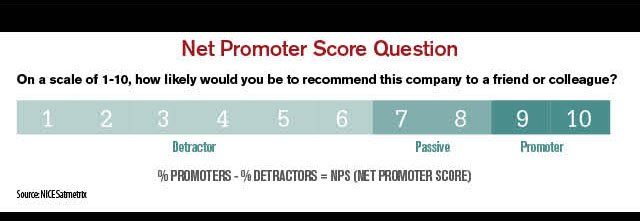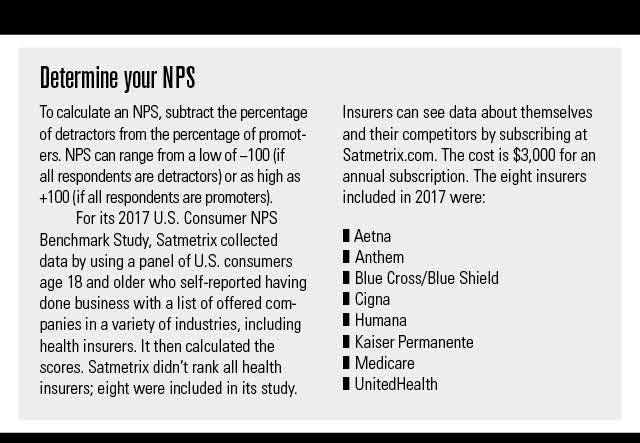How Your Net Promoter Score Could Influence Your Business
Your net promoter score could be influencing your business. Here’s what it is and how to improve it.
Do you know what your MCO’s net promoter score (NPS) is? Or, perhaps the question should be, do you even know what an NPS is?
Although more than two-thirds of Fortune 1000 companies are now using this metric to evaluate performance and customers’ brand loyalty, health insurers have been slower to get on board. Perhaps this is one of the reasons why the health insurance industry overall ranks 21st among 23 industries that receive an NPS. This ranking is based on the average NPS each company within a category receives.
“NPS can have an impact on the health insurance industry; it is incumbent upon us to understand what the score means,” says Darnell Dent, Managed Healthcare Executive editorial advisor and president and CEO, FirstCare Health Plans, Austin, Texas. “This metric can be a wake-up call if a company needs to increase member engagement.”
NPS was developed by Bain & Company, Fred Reichheld, and Satmetrix, a provider of customer experience management software. Reichheld introduced the methodology in his 2003 Harvard Business Review article, “The One Number You Need to Grow.” NPS is calculated on a 10-point scale using responses to a single question: “How likely is it that you would recommend our company/product/service to a friend or colleague?”
“The NPS question is powerful because if something is meaningful enough for someone to refer it to someone else, then it shows that they have had a positive experience,” says Dent.
NPS responses fall into three categories:
- Promoters. These customers have the highest rates of repurchase and referral. They give ratings of nine or 10 to the question.
- Passives. These customers give ratings of seven or eight.
- Detractors. These customers give a score from zero to six.
“When customers rate a company high on the scale, they are acting as references and putting their own reputations on the line,” says Jessica Sullivan, assistant vice president, brand and marketing management, FirstCare.
Dent says promoters stand behind companies and often serve as champions for the brand. Satmetrix describes promoters as loyal enthusiasts who will keep buying and refer others, fueling growth, according to its website.
Although members in the passive group may be satisfied at a given time, they are labeled as an unenthusiastic group that is vulnerable to competitive offerings. “They may be happy at one moment because you fulfill a need, but they don’t have a real connection to your service or company,” Dent says.
Even though detractors may have been with a company for a while, they may score it low if something disappointed them recently. Satmetrix’s website describes detractors as unhappy customers who can damage your brand and impede growth through negative word-of-mouth.

According to Satmetrix, as of 2017, health insurers as a group were only ranked higher than cable/satellite TV and Internet service providers for their overall average NPS. Within the health insurer category, Oakland-California based Kaiser Permanente ranked the highest.
Next: NPS vs. CAHPS
NPS vs. CAHPS
One reason monitoring NPS may not have fully caught on with health insurers is that the industry is traditionally measured by Consumer Assessment of Healthcare Providers and Systems (CAHPS) scores. These scores provide an “apples-to-apples” comparison of member satisfaction scores across all NCQA-accredited health plans.
Yet there are several reasons to begin monitoring NPS, says Dent. Internally, it provides employees with visibility around company performance and can help drive corporate decisions regarding initiatives, product development, service, communication, and spend.
“NPS is a different way to view your customer base,” Sullivan says. “It reveals what customers really think about you. While customer satisfaction surveys disclose how a customer feels at a certain point in time, customer loyalty encompasses the whole experience.”
It can be particularly helpful to know NPS now, when many facets of healthcare are uncertain, Dent says. “It’s good to know what percentage of your customers are loyal across the board compared to those who might change their perception of you from one day to another.”
NPS is also a way for staff to understand the connection between their role and their customer impact, Dent says. For example, while sales and customer service employees may have a good understanding of how they rate with customers as a result of their direct interactions with them, information technology personnel and others who are more internally focused may not.

NPS + CAHPS
Since 2016, FirstCare has included the NPS question in its CAHPS survey even though it isn’t a requirement. “By integrating the two, we get a deeper dive and better understanding of why we may have a particular score and where we should focus our efforts for improvement,” says Dent.
To date, FirstCare has collected internal NPS for its different lines of business-Medicaid, marketplace, and commercial-through surveys delivered by email, mail, and phone. FirstCare then calculates its own scores using the Satmetrix scoring methodology. The NPS is calculated by subtracting the total number of detractors from the total number of promoters.
The survey conducted among FirstCare’s marketplace customers resulted in an NPS of 17 in 2016. In 2017, the score rose to 28. “We attribute the increase in the score to such efforts as welcoming and engaging members when they first enroll, as well as improved customer service and communication,” says Dent.
FirstCare received a -8 NPS for its commercial block of business from members who participated in a recent online survey. “The lower score may be the result of billing issues we had as a result of changing invoicing systems, which we have since resolved,” Dent says.
Given the growing importance of NPS, the insurer is investing more effort into capturing and improving its score. “For 2018, we are planning to establish a baseline among all of our product lines for NPS,” Sullivan says. “We are also making sure that we ask and score the NPS question uniformly across all of our different survey channels so we are sure it’s relevant and accurate. We will then analyze scores and factor them into strategy, initiatives, and communications.”
Next: Practical steps you can take
Here are some of the ways FirstCare is working to improve its score:
1. Increased online presence.
The insurer uses a combination of paid and organic social posts to draw people to its social channels. It has also introduced more video marketing to increase brand awareness. “The goal is to engage members, gain interest from prospective customers, and involve employees,” Sullivan says. The company is adding more digital ads and enhancing its website presence with search engine optimization. It also plans to launch a blog for employers and brokers who make decisions about health plans.
2. Improved self-service.
Offered through its member self-service portal, online tools help customers understand the changing face of healthcare. Examples include counters showing a member’s deductible, out-of-pocket maximum, and claims information; medical benefits and prescription drug information; an online provider finder; cost estimators; and, wellness tools.
3. Enhanced ID cards.
ID cards are now easier to read and include additional important phone numbers and quick references for members to get the information they need quickly. Instead of a laminated paper card, they are durable plastic.
4. Rethinking member touchpoints.
FirstCare is evaluating how staff members answer the phone, what members see online, what they receive in the mail and via email, and how prospective members might engage with FirstCare in the community. The organization wants to be seen as more member centered. “One example is changing the name of our call center to ‘customer service’ center,” Dent says. “We need to continue to steer away from referring to our offerings from an operational standpoint and move to descriptions that are more meaningful to and reflective of our customers.”
5. Increased communications.
FirstCare is increasing its direct email communications to membership. For example, it provides reminders to members regarding flu shots and scheduling wellness check ups with primary care physicians. It is also increasing the number of contact points members can use to ask questions.

Karen Appold is a medical writer in Lehigh Valley, Pennsylvania.
Extending the Capabilities of the EHR Through Automation
August 2nd 2023Welcome back to another episode of "Tuning In to the C-Suite," where Briana Contreras, an editor of Managed Healthcare Executive, had the pleasure of chatting with Cindy Gaines, chief clinical transformation officer at Lumeon.
Listen
Automate Your Practice's Workflows with These 5 Tools
October 4th 2023To maintain patient satisfaction and regulatory compliance and reduce potential clerical errors while maintaining high productivity, you can ease your staff’s burdens by automating your practice’s workflows and empower your staff to do more in less time.
Read More